Project Design, Implementation, and Evaluation of Bandcamp Features
VerifiedAdded on 2024/06/10
|40
|6314
|314
Project
AI Summary
This project focuses on the design, implementation, and evaluation of new features for Bandcamp, specifically the integration of a playlist creation service. The project outlines the requirement specifications, feasibility studies, and user feedback processes involved in selecting and implementing the 'Grove on the playlist' feature. It details the project's objectives, methods, human resource implications, and work breakdown structure, emphasizing the importance of user reviews, budget considerations, and technical skills in the project selection process. The report includes a specification for the agreed project, outlining objectives, methods, and resource implications, along with a project plan detailing the work breakdown structure and time allocation for each phase.
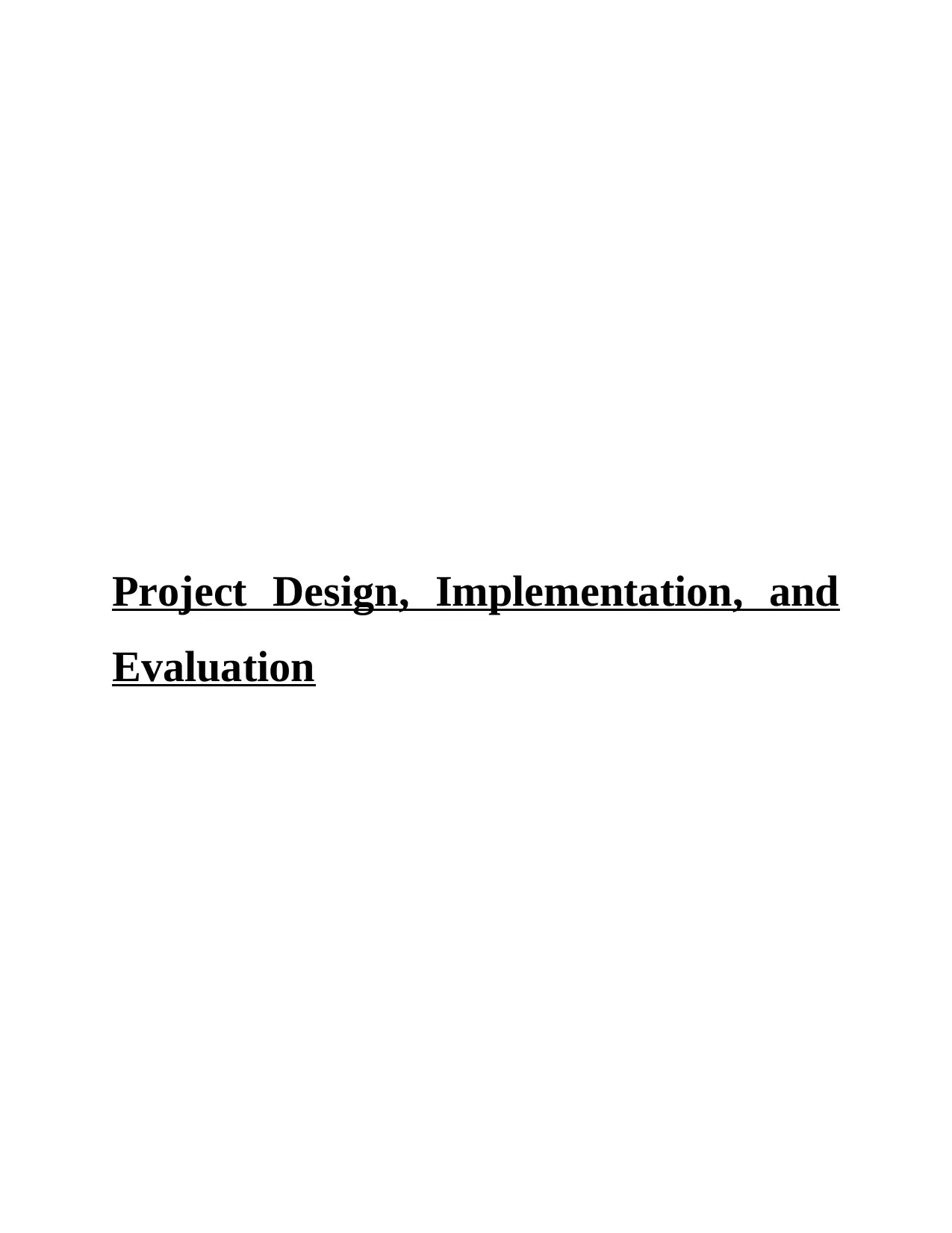
Project Design, Implementation, and
Evaluation
Evaluation
Paraphrase This Document
Need a fresh take? Get an instant paraphrase of this document with our AI Paraphraser
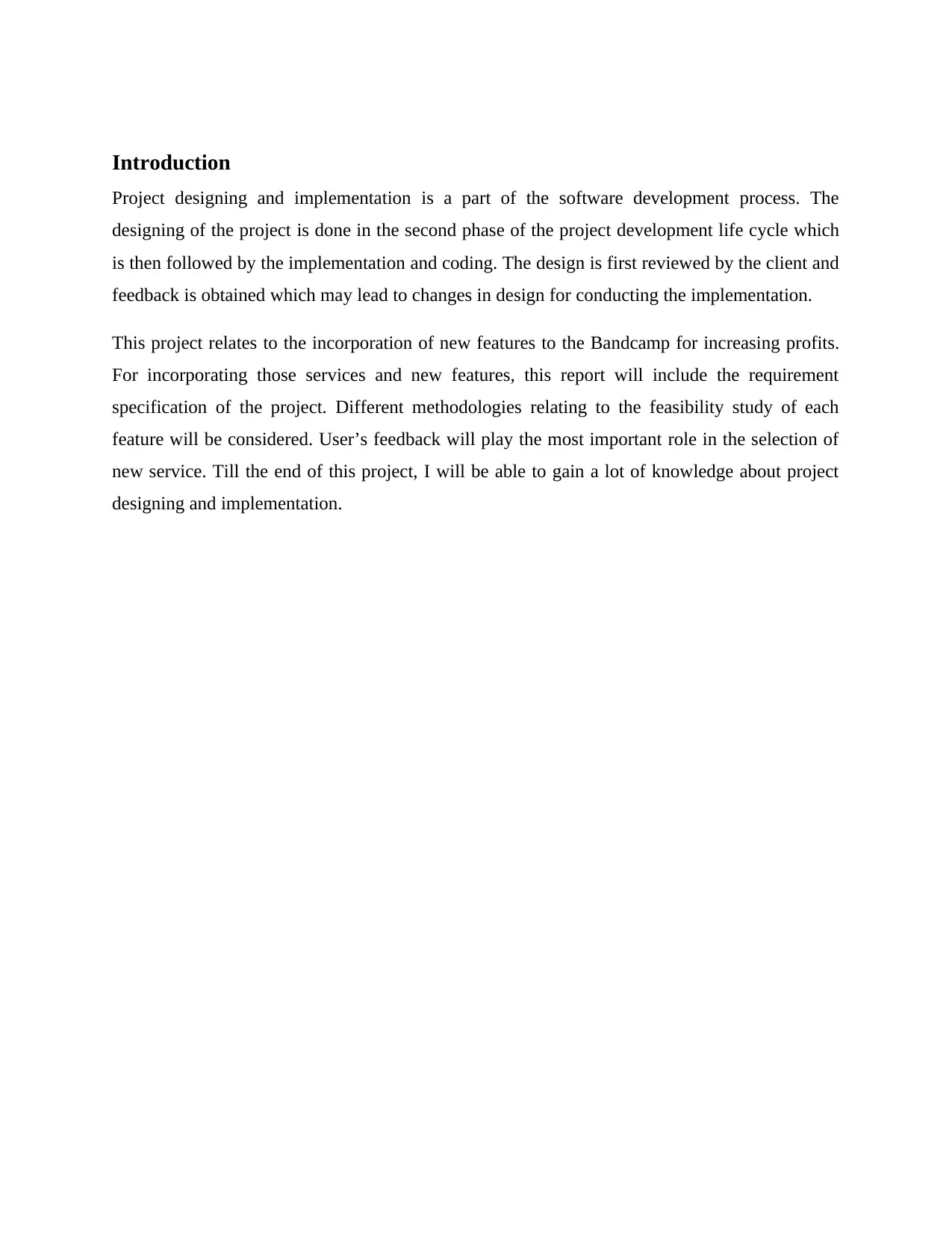
Introduction
Project designing and implementation is a part of the software development process. The
designing of the project is done in the second phase of the project development life cycle which
is then followed by the implementation and coding. The design is first reviewed by the client and
feedback is obtained which may lead to changes in design for conducting the implementation.
This project relates to the incorporation of new features to the Bandcamp for increasing profits.
For incorporating those services and new features, this report will include the requirement
specification of the project. Different methodologies relating to the feasibility study of each
feature will be considered. User’s feedback will play the most important role in the selection of
new service. Till the end of this project, I will be able to gain a lot of knowledge about project
designing and implementation.
Project designing and implementation is a part of the software development process. The
designing of the project is done in the second phase of the project development life cycle which
is then followed by the implementation and coding. The design is first reviewed by the client and
feedback is obtained which may lead to changes in design for conducting the implementation.
This project relates to the incorporation of new features to the Bandcamp for increasing profits.
For incorporating those services and new features, this report will include the requirement
specification of the project. Different methodologies relating to the feasibility study of each
feature will be considered. User’s feedback will play the most important role in the selection of
new service. Till the end of this project, I will be able to gain a lot of knowledge about project
designing and implementation.
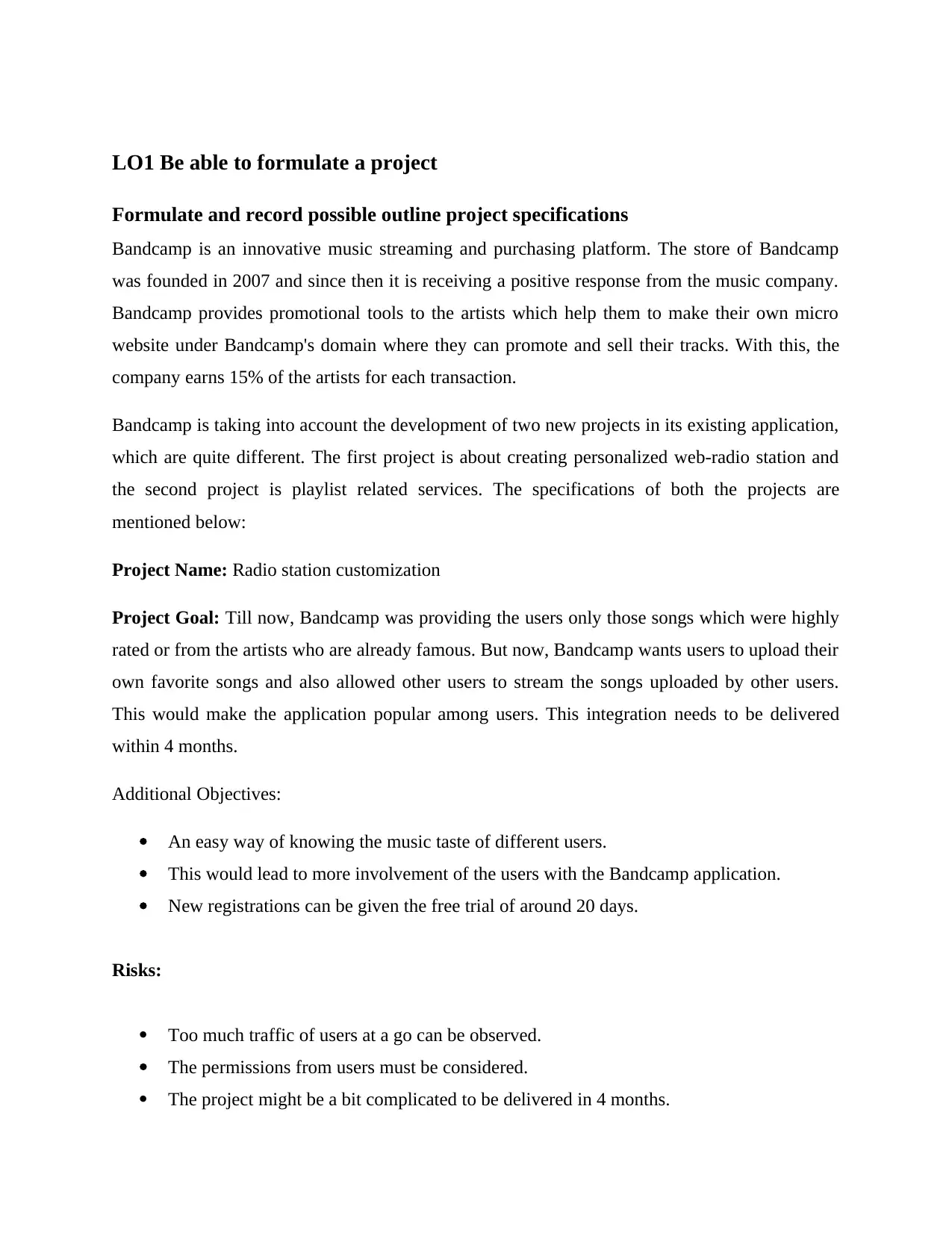
LO1 Be able to formulate a project
Formulate and record possible outline project specifications
Bandcamp is an innovative music streaming and purchasing platform. The store of Bandcamp
was founded in 2007 and since then it is receiving a positive response from the music company.
Bandcamp provides promotional tools to the artists which help them to make their own micro
website under Bandcamp's domain where they can promote and sell their tracks. With this, the
company earns 15% of the artists for each transaction.
Bandcamp is taking into account the development of two new projects in its existing application,
which are quite different. The first project is about creating personalized web-radio station and
the second project is playlist related services. The specifications of both the projects are
mentioned below:
Project Name: Radio station customization
Project Goal: Till now, Bandcamp was providing the users only those songs which were highly
rated or from the artists who are already famous. But now, Bandcamp wants users to upload their
own favorite songs and also allowed other users to stream the songs uploaded by other users.
This would make the application popular among users. This integration needs to be delivered
within 4 months.
Additional Objectives:
An easy way of knowing the music taste of different users.
This would lead to more involvement of the users with the Bandcamp application.
New registrations can be given the free trial of around 20 days.
Risks:
Too much traffic of users at a go can be observed.
The permissions from users must be considered.
The project might be a bit complicated to be delivered in 4 months.
Formulate and record possible outline project specifications
Bandcamp is an innovative music streaming and purchasing platform. The store of Bandcamp
was founded in 2007 and since then it is receiving a positive response from the music company.
Bandcamp provides promotional tools to the artists which help them to make their own micro
website under Bandcamp's domain where they can promote and sell their tracks. With this, the
company earns 15% of the artists for each transaction.
Bandcamp is taking into account the development of two new projects in its existing application,
which are quite different. The first project is about creating personalized web-radio station and
the second project is playlist related services. The specifications of both the projects are
mentioned below:
Project Name: Radio station customization
Project Goal: Till now, Bandcamp was providing the users only those songs which were highly
rated or from the artists who are already famous. But now, Bandcamp wants users to upload their
own favorite songs and also allowed other users to stream the songs uploaded by other users.
This would make the application popular among users. This integration needs to be delivered
within 4 months.
Additional Objectives:
An easy way of knowing the music taste of different users.
This would lead to more involvement of the users with the Bandcamp application.
New registrations can be given the free trial of around 20 days.
Risks:
Too much traffic of users at a go can be observed.
The permissions from users must be considered.
The project might be a bit complicated to be delivered in 4 months.
⊘ This is a preview!⊘
Do you want full access?
Subscribe today to unlock all pages.

Trusted by 1+ million students worldwide
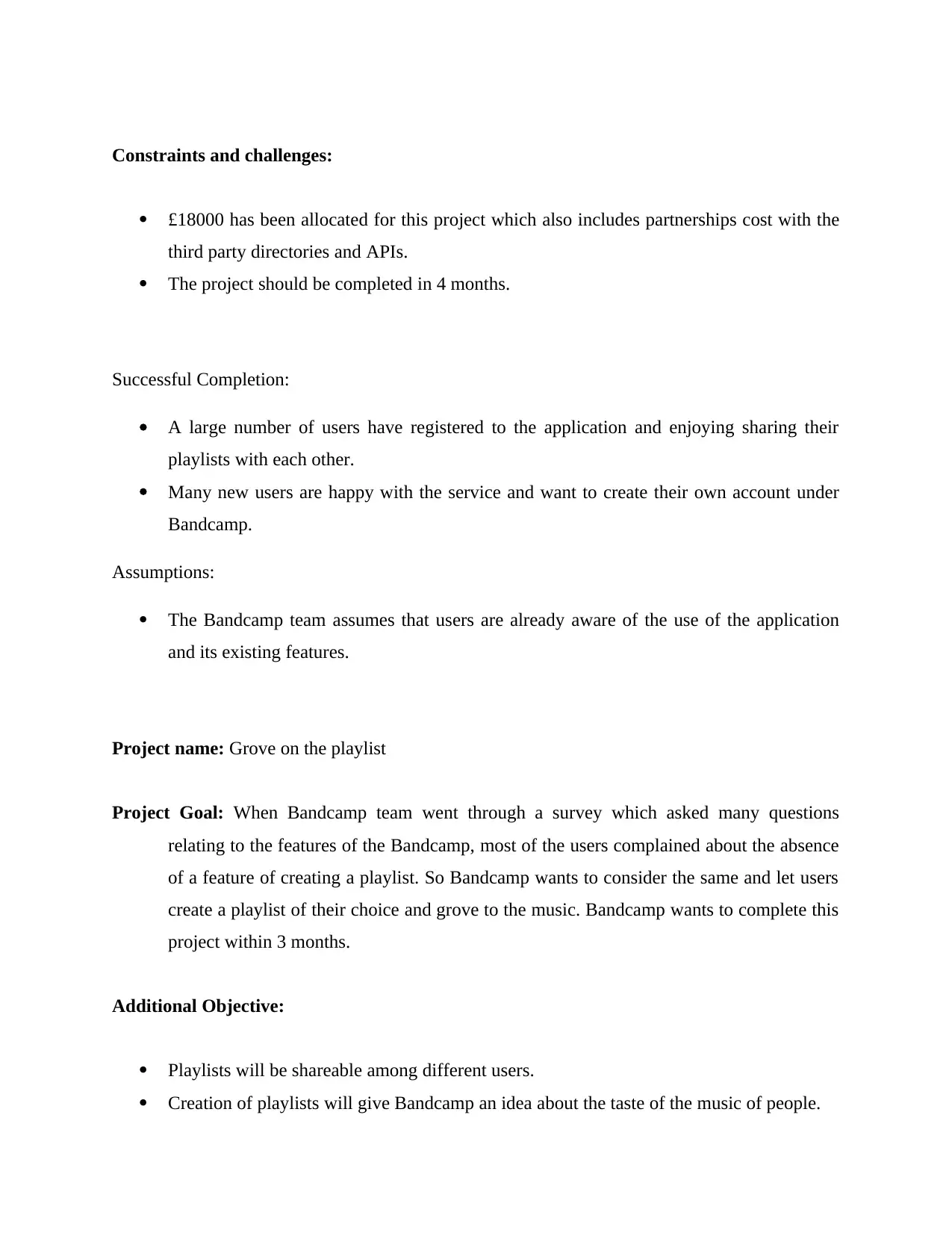
Constraints and challenges:
£18000 has been allocated for this project which also includes partnerships cost with the
third party directories and APIs.
The project should be completed in 4 months.
Successful Completion:
A large number of users have registered to the application and enjoying sharing their
playlists with each other.
Many new users are happy with the service and want to create their own account under
Bandcamp.
Assumptions:
The Bandcamp team assumes that users are already aware of the use of the application
and its existing features.
Project name: Grove on the playlist
Project Goal: When Bandcamp team went through a survey which asked many questions
relating to the features of the Bandcamp, most of the users complained about the absence
of a feature of creating a playlist. So Bandcamp wants to consider the same and let users
create a playlist of their choice and grove to the music. Bandcamp wants to complete this
project within 3 months.
Additional Objective:
Playlists will be shareable among different users.
Creation of playlists will give Bandcamp an idea about the taste of the music of people.
£18000 has been allocated for this project which also includes partnerships cost with the
third party directories and APIs.
The project should be completed in 4 months.
Successful Completion:
A large number of users have registered to the application and enjoying sharing their
playlists with each other.
Many new users are happy with the service and want to create their own account under
Bandcamp.
Assumptions:
The Bandcamp team assumes that users are already aware of the use of the application
and its existing features.
Project name: Grove on the playlist
Project Goal: When Bandcamp team went through a survey which asked many questions
relating to the features of the Bandcamp, most of the users complained about the absence
of a feature of creating a playlist. So Bandcamp wants to consider the same and let users
create a playlist of their choice and grove to the music. Bandcamp wants to complete this
project within 3 months.
Additional Objective:
Playlists will be shareable among different users.
Creation of playlists will give Bandcamp an idea about the taste of the music of people.
Paraphrase This Document
Need a fresh take? Get an instant paraphrase of this document with our AI Paraphraser
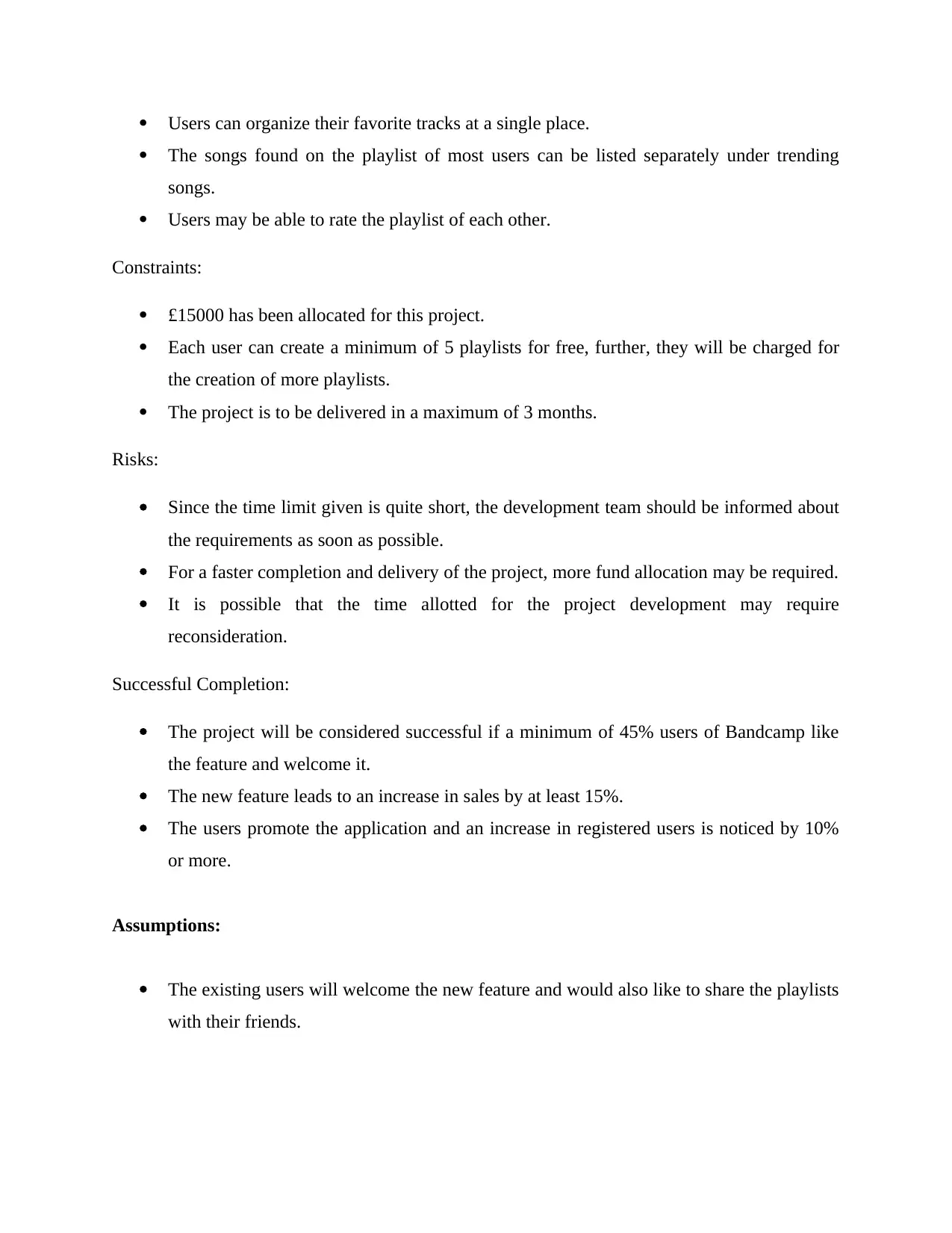
Users can organize their favorite tracks at a single place.
The songs found on the playlist of most users can be listed separately under trending
songs.
Users may be able to rate the playlist of each other.
Constraints:
£15000 has been allocated for this project.
Each user can create a minimum of 5 playlists for free, further, they will be charged for
the creation of more playlists.
The project is to be delivered in a maximum of 3 months.
Risks:
Since the time limit given is quite short, the development team should be informed about
the requirements as soon as possible.
For a faster completion and delivery of the project, more fund allocation may be required.
It is possible that the time allotted for the project development may require
reconsideration.
Successful Completion:
The project will be considered successful if a minimum of 45% users of Bandcamp like
the feature and welcome it.
The new feature leads to an increase in sales by at least 15%.
The users promote the application and an increase in registered users is noticed by 10%
or more.
Assumptions:
The existing users will welcome the new feature and would also like to share the playlists
with their friends.
The songs found on the playlist of most users can be listed separately under trending
songs.
Users may be able to rate the playlist of each other.
Constraints:
£15000 has been allocated for this project.
Each user can create a minimum of 5 playlists for free, further, they will be charged for
the creation of more playlists.
The project is to be delivered in a maximum of 3 months.
Risks:
Since the time limit given is quite short, the development team should be informed about
the requirements as soon as possible.
For a faster completion and delivery of the project, more fund allocation may be required.
It is possible that the time allotted for the project development may require
reconsideration.
Successful Completion:
The project will be considered successful if a minimum of 45% users of Bandcamp like
the feature and welcome it.
The new feature leads to an increase in sales by at least 15%.
The users promote the application and an increase in registered users is noticed by 10%
or more.
Assumptions:
The existing users will welcome the new feature and would also like to share the playlists
with their friends.
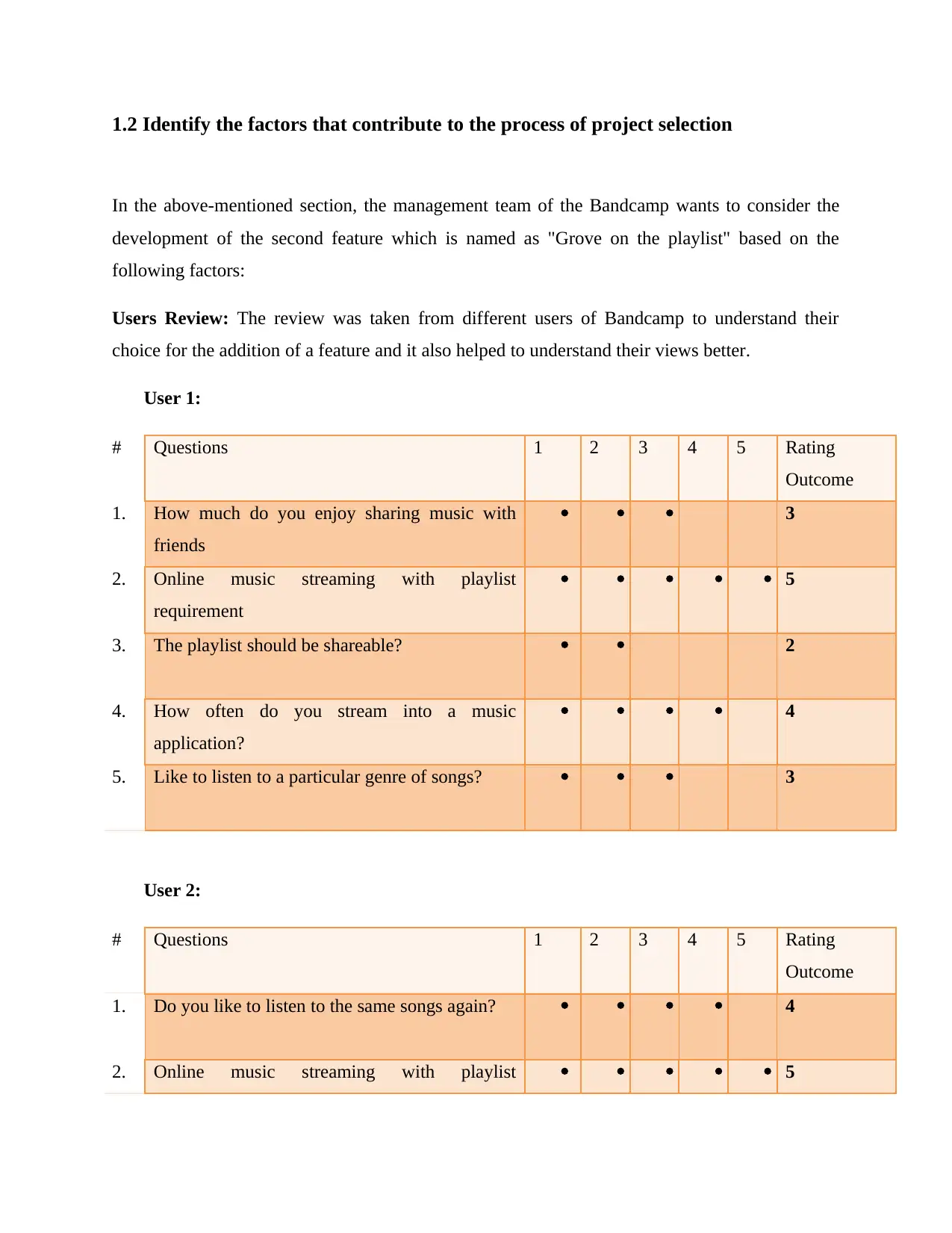
1.2 Identify the factors that contribute to the process of project selection
In the above-mentioned section, the management team of the Bandcamp wants to consider the
development of the second feature which is named as "Grove on the playlist" based on the
following factors:
Users Review: The review was taken from different users of Bandcamp to understand their
choice for the addition of a feature and it also helped to understand their views better.
User 1:
# Questions 1 2 3 4 5 Rating
Outcome
1. How much do you enjoy sharing music with
friends
3
2. Online music streaming with playlist
requirement
5
3. The playlist should be shareable? 2
4. How often do you stream into a music
application?
4
5. Like to listen to a particular genre of songs? 3
User 2:
# Questions 1 2 3 4 5 Rating
Outcome
1. Do you like to listen to the same songs again? 4
2. Online music streaming with playlist 5
In the above-mentioned section, the management team of the Bandcamp wants to consider the
development of the second feature which is named as "Grove on the playlist" based on the
following factors:
Users Review: The review was taken from different users of Bandcamp to understand their
choice for the addition of a feature and it also helped to understand their views better.
User 1:
# Questions 1 2 3 4 5 Rating
Outcome
1. How much do you enjoy sharing music with
friends
3
2. Online music streaming with playlist
requirement
5
3. The playlist should be shareable? 2
4. How often do you stream into a music
application?
4
5. Like to listen to a particular genre of songs? 3
User 2:
# Questions 1 2 3 4 5 Rating
Outcome
1. Do you like to listen to the same songs again? 4
2. Online music streaming with playlist 5
⊘ This is a preview!⊘
Do you want full access?
Subscribe today to unlock all pages.

Trusted by 1+ million students worldwide
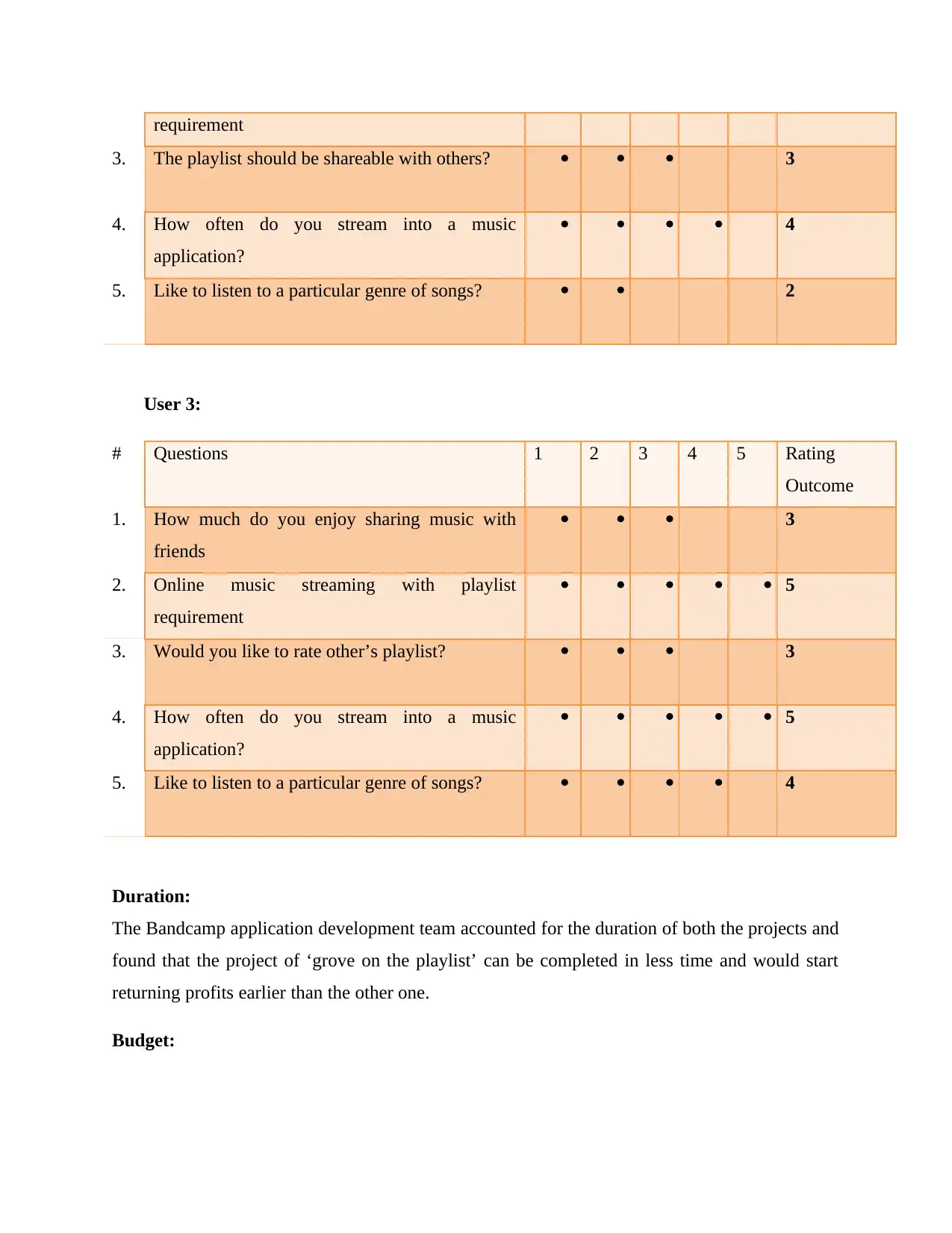
requirement
3. The playlist should be shareable with others? 3
4. How often do you stream into a music
application?
4
5. Like to listen to a particular genre of songs? 2
User 3:
# Questions 1 2 3 4 5 Rating
Outcome
1. How much do you enjoy sharing music with
friends
3
2. Online music streaming with playlist
requirement
5
3. Would you like to rate other’s playlist? 3
4. How often do you stream into a music
application?
5
5. Like to listen to a particular genre of songs? 4
Duration:
The Bandcamp application development team accounted for the duration of both the projects and
found that the project of ‘grove on the playlist’ can be completed in less time and would start
returning profits earlier than the other one.
Budget:
3. The playlist should be shareable with others? 3
4. How often do you stream into a music
application?
4
5. Like to listen to a particular genre of songs? 2
User 3:
# Questions 1 2 3 4 5 Rating
Outcome
1. How much do you enjoy sharing music with
friends
3
2. Online music streaming with playlist
requirement
5
3. Would you like to rate other’s playlist? 3
4. How often do you stream into a music
application?
5
5. Like to listen to a particular genre of songs? 4
Duration:
The Bandcamp application development team accounted for the duration of both the projects and
found that the project of ‘grove on the playlist’ can be completed in less time and would start
returning profits earlier than the other one.
Budget:
Paraphrase This Document
Need a fresh take? Get an instant paraphrase of this document with our AI Paraphraser
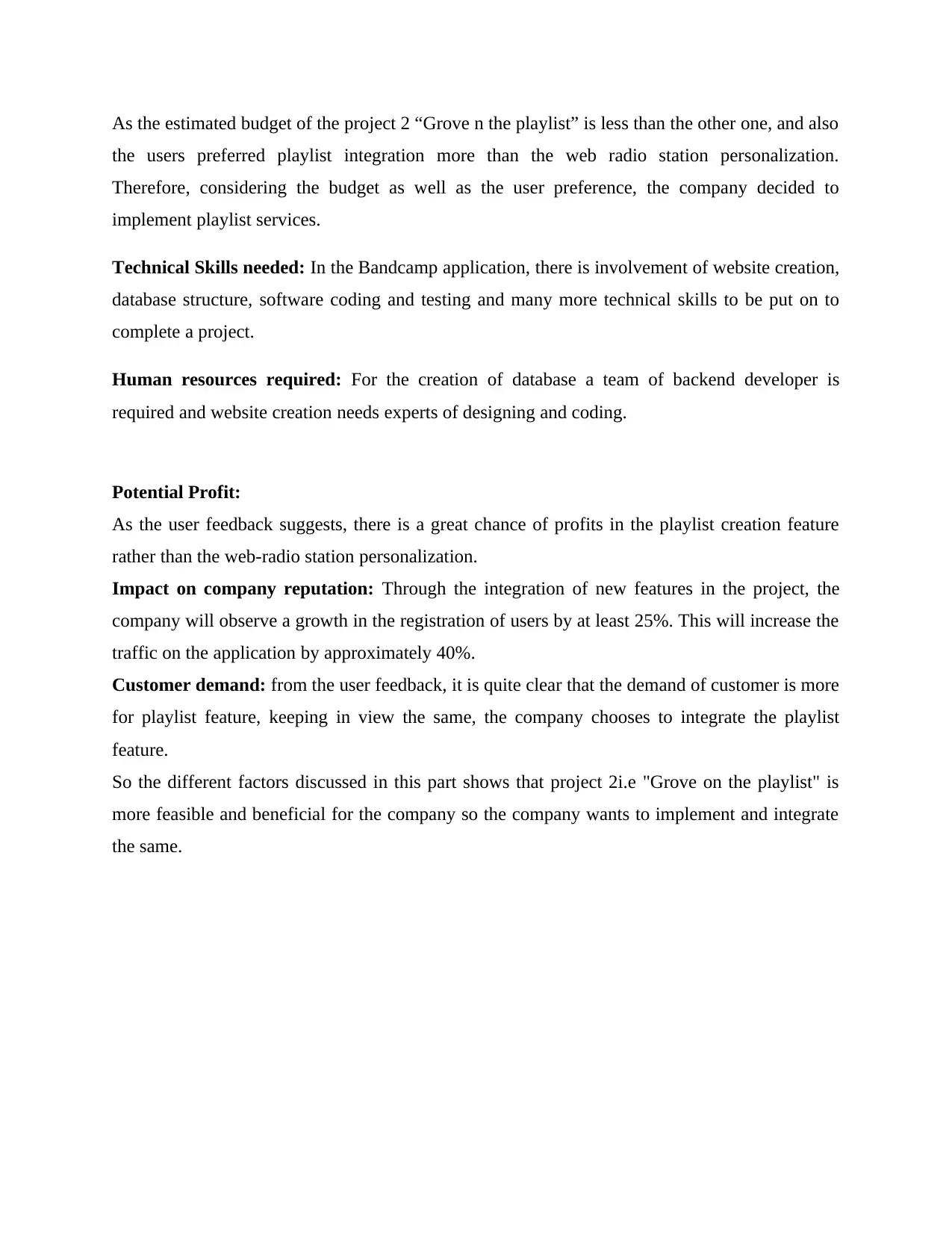
As the estimated budget of the project 2 “Grove n the playlist” is less than the other one, and also
the users preferred playlist integration more than the web radio station personalization.
Therefore, considering the budget as well as the user preference, the company decided to
implement playlist services.
Technical Skills needed: In the Bandcamp application, there is involvement of website creation,
database structure, software coding and testing and many more technical skills to be put on to
complete a project.
Human resources required: For the creation of database a team of backend developer is
required and website creation needs experts of designing and coding.
Potential Profit:
As the user feedback suggests, there is a great chance of profits in the playlist creation feature
rather than the web-radio station personalization.
Impact on company reputation: Through the integration of new features in the project, the
company will observe a growth in the registration of users by at least 25%. This will increase the
traffic on the application by approximately 40%.
Customer demand: from the user feedback, it is quite clear that the demand of customer is more
for playlist feature, keeping in view the same, the company chooses to integrate the playlist
feature.
So the different factors discussed in this part shows that project 2i.e "Grove on the playlist" is
more feasible and beneficial for the company so the company wants to implement and integrate
the same.
the users preferred playlist integration more than the web radio station personalization.
Therefore, considering the budget as well as the user preference, the company decided to
implement playlist services.
Technical Skills needed: In the Bandcamp application, there is involvement of website creation,
database structure, software coding and testing and many more technical skills to be put on to
complete a project.
Human resources required: For the creation of database a team of backend developer is
required and website creation needs experts of designing and coding.
Potential Profit:
As the user feedback suggests, there is a great chance of profits in the playlist creation feature
rather than the web-radio station personalization.
Impact on company reputation: Through the integration of new features in the project, the
company will observe a growth in the registration of users by at least 25%. This will increase the
traffic on the application by approximately 40%.
Customer demand: from the user feedback, it is quite clear that the demand of customer is more
for playlist feature, keeping in view the same, the company chooses to integrate the playlist
feature.
So the different factors discussed in this part shows that project 2i.e "Grove on the playlist" is
more feasible and beneficial for the company so the company wants to implement and integrate
the same.
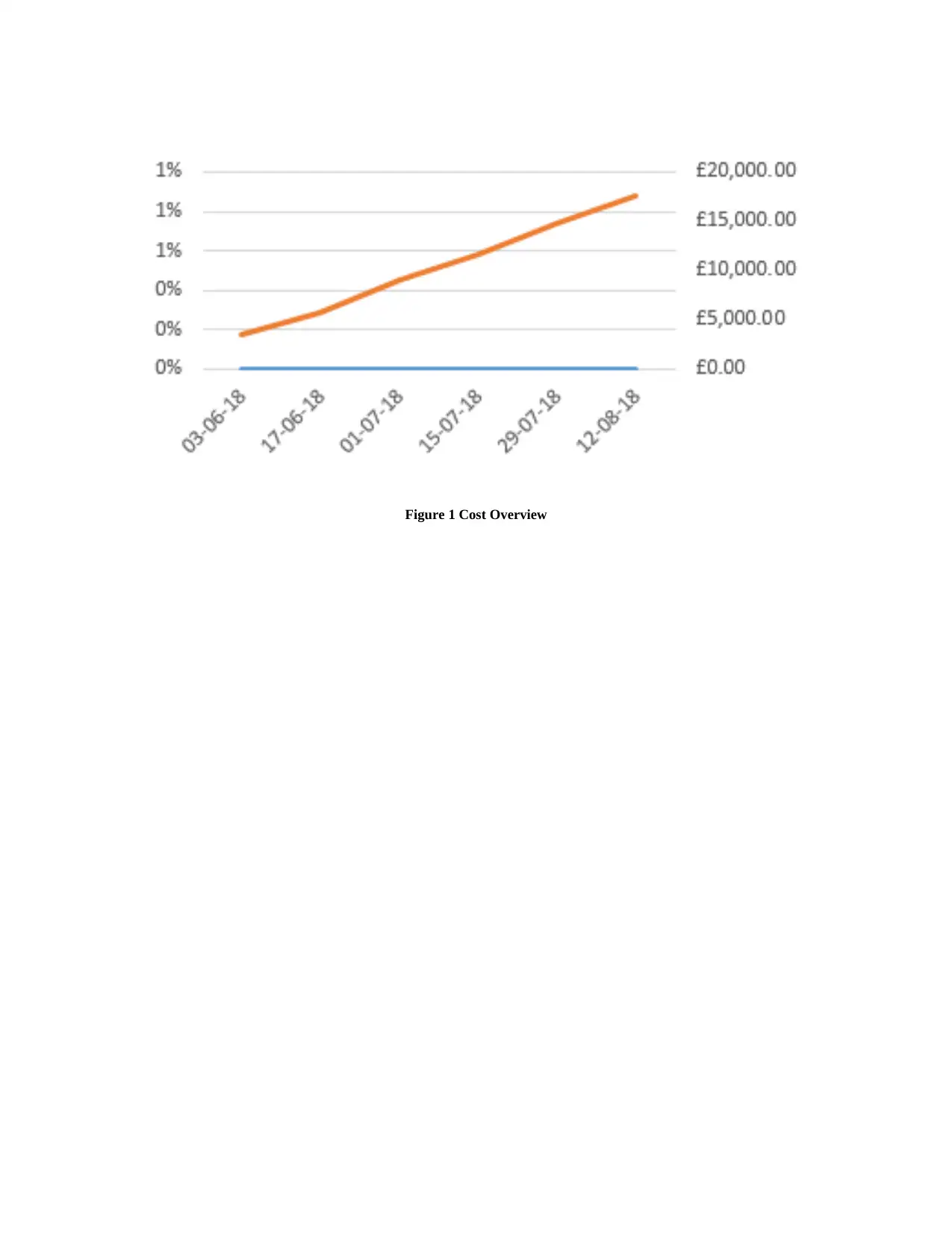
Figure 1 Cost Overview
⊘ This is a preview!⊘
Do you want full access?
Subscribe today to unlock all pages.

Trusted by 1+ million students worldwide
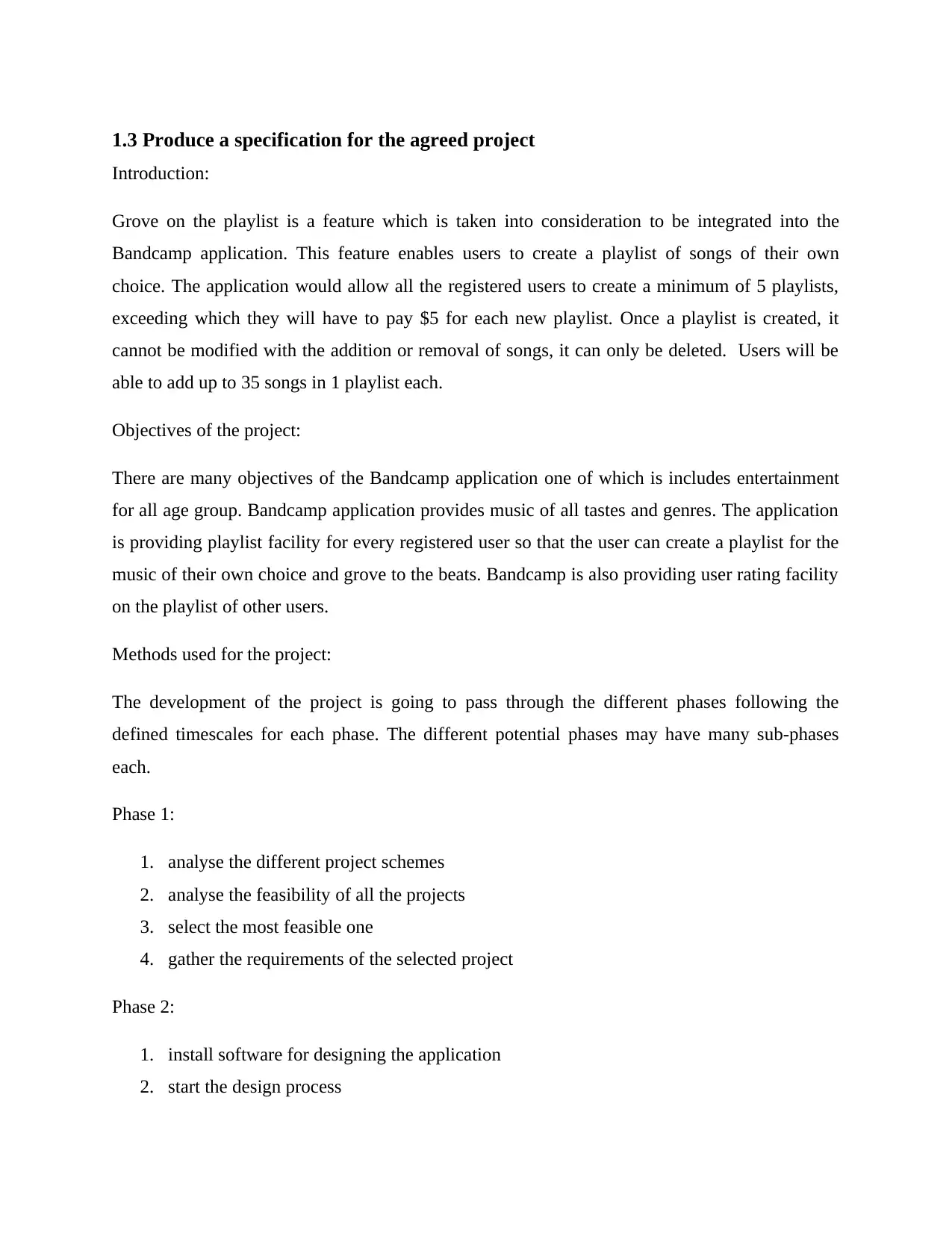
1.3 Produce a specification for the agreed project
Introduction:
Grove on the playlist is a feature which is taken into consideration to be integrated into the
Bandcamp application. This feature enables users to create a playlist of songs of their own
choice. The application would allow all the registered users to create a minimum of 5 playlists,
exceeding which they will have to pay $5 for each new playlist. Once a playlist is created, it
cannot be modified with the addition or removal of songs, it can only be deleted. Users will be
able to add up to 35 songs in 1 playlist each.
Objectives of the project:
There are many objectives of the Bandcamp application one of which is includes entertainment
for all age group. Bandcamp application provides music of all tastes and genres. The application
is providing playlist facility for every registered user so that the user can create a playlist for the
music of their own choice and grove to the beats. Bandcamp is also providing user rating facility
on the playlist of other users.
Methods used for the project:
The development of the project is going to pass through the different phases following the
defined timescales for each phase. The different potential phases may have many sub-phases
each.
Phase 1:
1. analyse the different project schemes
2. analyse the feasibility of all the projects
3. select the most feasible one
4. gather the requirements of the selected project
Phase 2:
1. install software for designing the application
2. start the design process
Introduction:
Grove on the playlist is a feature which is taken into consideration to be integrated into the
Bandcamp application. This feature enables users to create a playlist of songs of their own
choice. The application would allow all the registered users to create a minimum of 5 playlists,
exceeding which they will have to pay $5 for each new playlist. Once a playlist is created, it
cannot be modified with the addition or removal of songs, it can only be deleted. Users will be
able to add up to 35 songs in 1 playlist each.
Objectives of the project:
There are many objectives of the Bandcamp application one of which is includes entertainment
for all age group. Bandcamp application provides music of all tastes and genres. The application
is providing playlist facility for every registered user so that the user can create a playlist for the
music of their own choice and grove to the beats. Bandcamp is also providing user rating facility
on the playlist of other users.
Methods used for the project:
The development of the project is going to pass through the different phases following the
defined timescales for each phase. The different potential phases may have many sub-phases
each.
Phase 1:
1. analyse the different project schemes
2. analyse the feasibility of all the projects
3. select the most feasible one
4. gather the requirements of the selected project
Phase 2:
1. install software for designing the application
2. start the design process
Paraphrase This Document
Need a fresh take? Get an instant paraphrase of this document with our AI Paraphraser
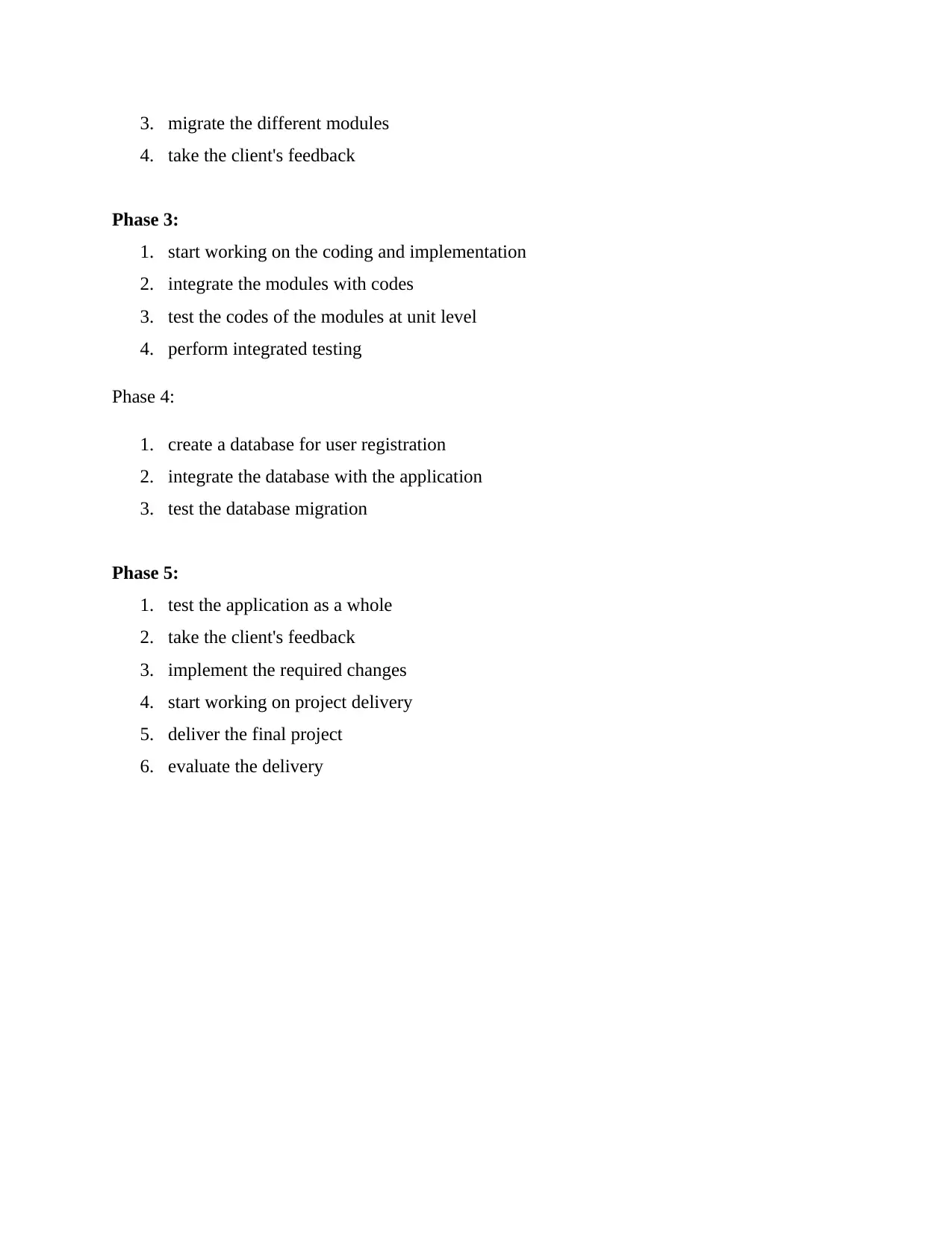
3. migrate the different modules
4. take the client's feedback
Phase 3:
1. start working on the coding and implementation
2. integrate the modules with codes
3. test the codes of the modules at unit level
4. perform integrated testing
Phase 4:
1. create a database for user registration
2. integrate the database with the application
3. test the database migration
Phase 5:
1. test the application as a whole
2. take the client's feedback
3. implement the required changes
4. start working on project delivery
5. deliver the final project
6. evaluate the delivery
4. take the client's feedback
Phase 3:
1. start working on the coding and implementation
2. integrate the modules with codes
3. test the codes of the modules at unit level
4. perform integrated testing
Phase 4:
1. create a database for user registration
2. integrate the database with the application
3. test the database migration
Phase 5:
1. test the application as a whole
2. take the client's feedback
3. implement the required changes
4. start working on project delivery
5. deliver the final project
6. evaluate the delivery
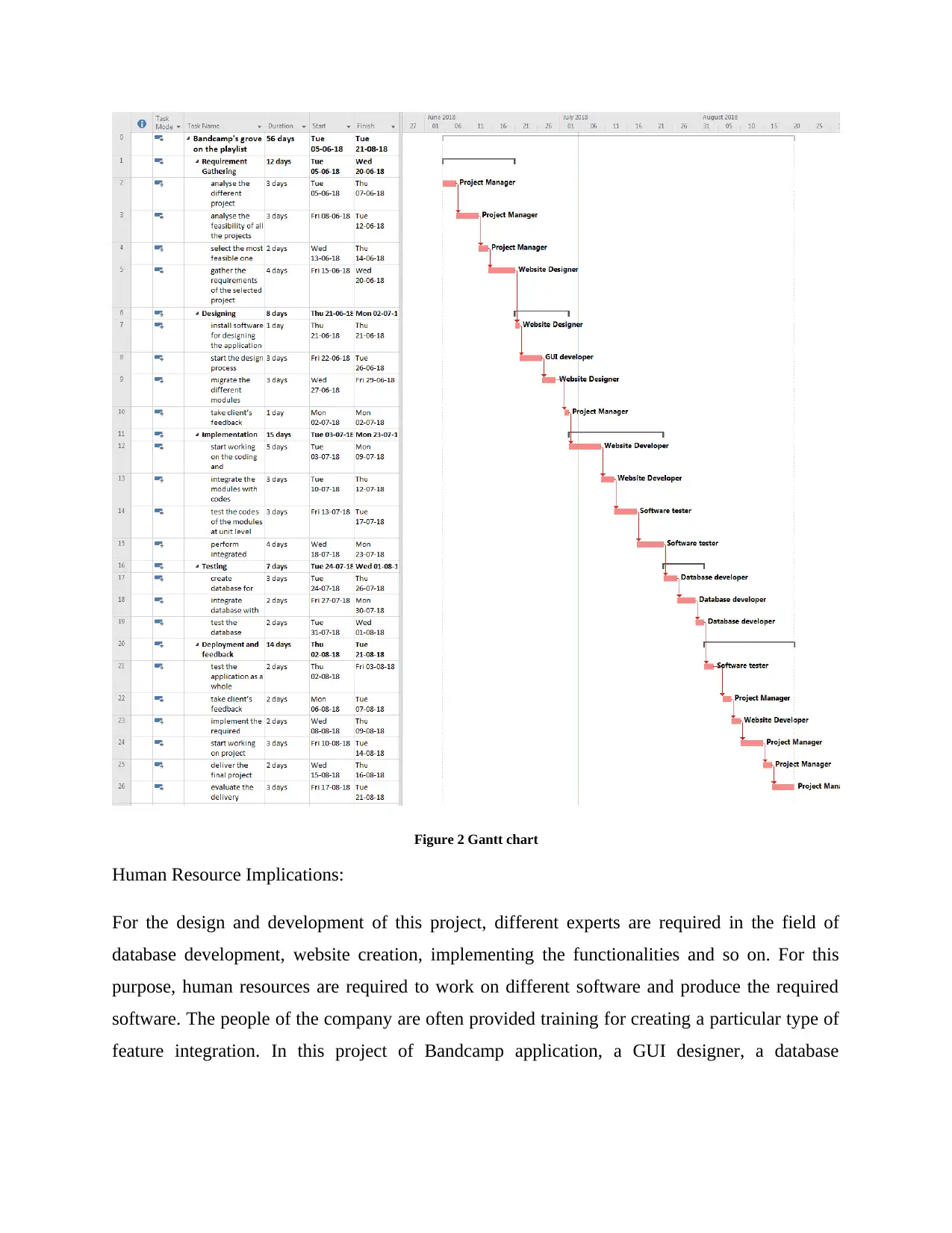
Figure 2 Gantt chart
Human Resource Implications:
For the design and development of this project, different experts are required in the field of
database development, website creation, implementing the functionalities and so on. For this
purpose, human resources are required to work on different software and produce the required
software. The people of the company are often provided training for creating a particular type of
feature integration. In this project of Bandcamp application, a GUI designer, a database
Human Resource Implications:
For the design and development of this project, different experts are required in the field of
database development, website creation, implementing the functionalities and so on. For this
purpose, human resources are required to work on different software and produce the required
software. The people of the company are often provided training for creating a particular type of
feature integration. In this project of Bandcamp application, a GUI designer, a database
⊘ This is a preview!⊘
Do you want full access?
Subscribe today to unlock all pages.

Trusted by 1+ million students worldwide
1 out of 40
Related Documents
Your All-in-One AI-Powered Toolkit for Academic Success.
+13062052269
info@desklib.com
Available 24*7 on WhatsApp / Email
![[object Object]](/_next/static/media/star-bottom.7253800d.svg)
Unlock your academic potential
Copyright © 2020–2025 A2Z Services. All Rights Reserved. Developed and managed by ZUCOL.




